Google tweaks its search algorithms at least once a day, with the aim of providing increasingly accurate results for every search query.
Such a rapid pace of change can cause concern among marketers and it is easy to see why. Organic search drives over 53% of all website traffic. So, if Google changes the rules, it can fundamentally affect the quantity and quality of online visits that any business receives.
Among the tiny tweaks indecipherable to the naked eye, the search giant has also launched a small number of what it terms “broad core algorithm updates” since 2018. These are announced via official Google channels, historically from the Google SearchLiaison X account, but now from the Google Search Central X account.
Next, this article will assess the new, markedly different age of algorithm updates we live in today with a focus on “broad core changes” and Artificial Intelligence (AI) features that have now become habitual in the industry.
- Google in 2025
- Major Google algorithm updates: A brief history
- Google core updates
- The AI transformation: Beyond algorithm updates
- How should marketers respond to these updates?
The 2024 Google documentation leak provided rare insights into Google’s algorithm, but marketers must still be prepared for constant change.
This is particularly true as the very nature of search is being redefined. ChatGPT, Perplexity, and other AI-powered alternatives are increasingly where users turn for answers, forcing Google to evolve beyond its traditional search model. AI Overviews now appear for billions of queries globally, while AI Mode offers an entirely different search experience. Google is no longer just indexing the web – it’s synthesizing it.
Yet paradoxically, this makes traditional search engine optimization (SEO) more important, not less. The sites that Google’s AI systems choose to reference are those with the strongest foundations: robust technical SEO, genuine expertise, and comprehensive content. The difference now is that success means both ranking in traditional search and being the source that AI systems trust to cite, thus, marketers need to find a balance in efforts towards AI and SEO.
Today, marketers need to keep a close eye on Google’s core algorithm updates, as well as the flashy new AI features that make global headlines.
To understand how we got here, it is worth quickly recapping the most important historical Google updates.
Major Google algorithm updates: A brief history
Panda
Initial launch: 2011
What is Panda? Panda was a major algorithm update (with many iterations since its inception) that clamped down on content farms and sites with low-quality content.
Who did/does it affect? The initial Panda update affected about 12% of all queries and saw sites with thin content or high ad-to-text ratios drop in the rankings. Panda has been updated consistently since 2011 to include new data signals, including user engagement metrics (e.g., bounce rates and time spent on site), content comprehensiveness, authoritativeness, and site architecture. Its data is processed outside of the main Google index, much like that of the Penguin algorithm.
Penquin
Initial launch: 2012
What is Penguin? Known as the “Webspam Update” at first, Penguin targeted spam techniques that had helped sites climb the rankings. These techniques included black hat practices such as keyword stuffing and buying backlinks.
Who did/does it affect? It affected 3.1% of English queries at launch, but this soon expanded to a larger data set. Penguin has sent ripples through the industry to rival any other set of updates, and it now works in real time (rather than at intervals) to fine-tune the search results.
Hummingbird
Initial launch: 2013
What is Hummingbird? Perhaps one of the biggest core algorithm updates of all time, Hummingbird ushered in a new era of “semantic search”, powered by deeper understanding of user intent and Google’s vast Knowledge Graph.
Who did/does it affect? Hummingbird has affected how all queries are interpreted, but it has particularly benefited companies that work to create conversational search experiences. Google labeled this update “Hummingbird” because it is “precise and fast”.
RankBrain
Initial launch: 2015
What is RankBrain? Google announced in October 2015 that it had started using machine learning as a core part of its algorithm, through a technology it coined “RankBrain”.
Who did/does it affect? This affected pretty much everyone! RankBrain was said to be the third-most important aspect of the core algorithm, and its importance has been cemented over time. This means Google’s algorithms can adjust their assumptions based on user feedback in real time to provide increasingly accurate results.
Possum
Initial launch: 2016
What is Possum? Possum was an update that focused on improving the quality of local results, based on the exact location of the searcher and the quality of available results.
Who did/does it affect? Many businesses that sit just outside of a city’s geographical limits saw an increase in their visibility, as Google relaxed the fixed rules it previously had in place. Users also saw more variety in the search results, based on specific modifiers or the order of words in their search query.
The Mobile-First Index
Initial launch: 2018
What is the Mobile-First Index? Google starts using the mobile version of content for its search index, rather than the desktop version. This seismic shift marked the move to a mobile-first world.
Who did/does it affect? The roll-out has been very gradual, but all websites will be affected worldwide. Although it is taking time to get right, Google is completely committed to making this change. Webmasters should be monitoring Google crawl activity to see the impact of their shift to mobile-first indexing.
BERT update
Initial launch: October 2019
What is BERT? The BERT (Bidirectional Encoder Representations from Transformers) update helped Google better understand natural language and context within search queries.
Who did/does it affect? This update impacted about 10% of all search queries, and it was particularly beneficial for understanding long, conversational queries. This provided marketers with new opportunities to create great content without an over-reliance on using exact match keywords within their copy. BERT has also been an important step towards the more conversational Google experience we know today.
MUM (Multitask Unified Model)
Initial launch: May 2021
What is MUM? MUM is a transformative AI-driven update that allows Google to better understand and process complex search queries by leveraging multimodal data (text, images, and video) across multiple languages.
Who did/does it affect? MUM enhances Google’s ability to answer complex search queries that previously required multiple searches. For example, it can compare and synthesize data from various formats and languages to answer difficult queries, such as travel planning or product comparisons. This makes it a major update for industries dealing with complex, multi-step queries, such as travel, health, and ecommerce.
These foundational updates laid the groundwork for Google’s current capabilities. While they remain part of the core algorithm, the search landscape has shifted dramatically with the introduction of generative AI features that build upon these earlier innovations. Understanding this evolution helps explain why Google was positioned to rapidly deploy AI Overviews and other generative features when competitive pressure emerged.
These are just some of the headline acts, but they’re the ones that have done most to shape the current landscape. There is an exhaustive list of all updates up to the present day at Moz.
Google core updates
Google’s core updates have become a regular feature of its algorithm, with new releases several times a year. They are significant and regular enough to merit their own section of our guide to Google’s algorithm changes.
These updates are designed to improve how Google evaluates content and determines rankings. Unlike smaller, targeted updates, core updates affect a wide range of search queries, industries, and languages, meaning they can cause significant fluctuations in rankings across the web.
The 2018 core updates
MozCast, which measures the level of volatility in search results, recorded very high levels of activity between August 1 and 2 2018, suggesting that Google was making some big changes. This was confirmed by a tweet from Google’s Search Liaison.

At first glance, this appears to give very little away. The update was described as a “broad core” change and the later advice to webmasters was to “create great content”.
Looking at those tweets from March 2018, some further light was shed on the changes, however.
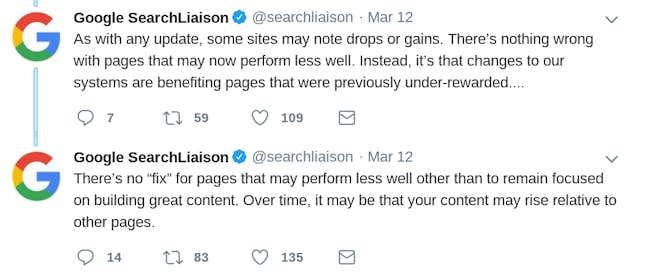
As noted in the introduction to this article, Google’s aim is to reward sites that provide useful, relevant content, rather than punishing sites that do not do so. Google never wanted to spend valuable engineering resources creating punitive updates, but some elements of the SEO industry necessitated the action.
The net result may be the same in some instances (if some sites are rewarded, others need to drop in the rankings), but the objective is significantly different.
E-E-A-T
In recent years, Google has tried to help site owners understand quality by emphasizing the E-E-A-T (Experience, Expertise, Authoritativeness, and Trustworthiness) framework. This framework has become even more critical in the AI era – these are the exact signals that determine whether Google’s AI systems will reference your content as a credible source.
Google’s broad core updates reward websites that demonstrate strong E-E-A-T signals. For instance, sites that provide clear author information, cite reputable sources, and offer real-world expertise are more likely to rank well.
- Experience was added in late 2022, expanding Google’s focus to consider whether the content creator has first-hand experience with the topic. This shift especially benefits industries where personal insight matters, like product reviews or health advice.
- Expertise and Authoritativeness relate to the creator’s credentials and the authoritativeness of the site or content itself. Google wants to ensure that content comes from individuals or organizations with recognized expertise in the field, particularly for YMYL (Your Money or Your Life) topics, such as health and finance. It also checks whether the website or page is a recognized authority or go-to source for the topic.
- Trustworthiness is a key measure of whether the site is safe, accurate, and credible. This is particularly important for sites offering advice, news, or transactional content, where accuracy is critical to user trust. Quality raters look at the creator, content, and website to assess trustworthiness.
May 2020 core update
Launch: May 2020
Impact: The May 2020 update was particularly impactful due to the timing, coming in the midst of the COVID-19 pandemic. It led to major shifts across sectors, with health, travel, and ecommerce sites being the most affected. Some reports indicated that sites with outdated or misleading content saw significant drops in traffic and rankings.
What it meant for marketers: Marketers needed to pay attention to content freshness and relevance, particularly in industries affected by the pandemic. The update highlighted the importance of providing up-to-date information, especially for industries like news, health, and ecommerce, where consumer behavior and needs were rapidly changing.

June and July 2021 core updates
Launch: June 2021 and July 2021
Impact: These updates were closely related to Google’s Page Experience Update, which introduced Core Web Vitals as ranking factors. These metrics, which include page load time, interactivity, and visual stability, were designed to improve user experience across mobile and desktop devices.
What it meant for marketers: Marketers needed to focus on technical SEO and website performance. Improving Core Web Vitals became essential for maintaining rankings. Businesses had to invest in improving page speed, reducing layout shifts, and ensuring a seamless experience across devices. It also reinforced the need to optimize for mobile as more users shifted to mobile browsing.
March 2023 core update
Launch: March 2023
Impact: The March 2023 core update was more volatile than expected, impacting a wide range of websites. Data from SEMrush showed large movements in YMYL sectors, especially health, where E-E-A-T became even more crucial. This update also reinforced Google’s focus on rewarding firsthand experience.

What it meant for marketers: For marketers, the March 2023 update emphasized the need to show firsthand experience and authority in content. Marketers had to revisit how they showcased expertise and ensure that author information and credentials were prominently displayed. Google increasingly favored content creators with verifiable expertise.
August 2024 core update
Launch: August 2024
Impact: The August 2024 core update was designed to reward small and independent publishers by promoting original, user-first content. Google aimed to surface the best of the web, focusing on authenticity and helpfulness while penalizing clickbait or overly optimized content. Reports fromSimilarweb noted significant ranking shifts across smaller sites, with many previously penalized websites seeing recovery.

What it meant for marketers: This update reaffirmed Google’s commitment to rewarding genuine content and providing opportunities for smaller publishers. Marketers needed to focus on producing authentic, original content that resonated with users rather than content created solely to rank well. This update was a reminder that overly optimized, clickbait-style content could lose visibility if it did not genuinely serve the user.
November 2024 core update
Launch: November 11 – December 5, 2024
Impact: The November 2024 core update took 24 days to complete, making it one of the longer rollouts of the year. Google stated this update was “designed to continue our work to improve the quality of our search results by showing more content that people find genuinely useful and less content that feels like it was made just to perform well on Search.”

The update showed heightened emphasis on original and high-quality content that aligns closely with user intent, with increased scrutiny on factors such as page load speed, mobile-friendliness, and overall site usability. Many sites that had been waiting for recovery from previous updates remained disappointed, as Google had warned weeks earlier not to expect major recoveries.
What it meant for marketers: This update made clear that Google was getting better at detecting content created primarily for search engines versus content that genuinely helps users. Sites with thin, templated, or AI-generated content without human oversight continued to struggle. The timing right before the holiday shopping season meant e-commerce sites had to quickly assess their content quality to protect seasonal revenue.
December 2024 core update
Launch: December 12 – December 18, 2024
Impact: The December 2024 core update spanned just six days, marking it as the fastest documented, official core update in Google’s history. Coming only a week after the November update finished, this unusual timing suggested Google was fine-tuning something specific. Despite its quick rollout, the update brought lots of volatility with many data providers citing it as more volatile than the November 2024 core update. Interestingly, many sites that lost visibility in November saw partial recoveries, while others experienced further declines.

What it meant for marketers: The back-to-back updates created significant uncertainty during the critical holiday shopping period. The rapid succession suggested Google was course-correcting aspects of the November update rather than introducing entirely new ranking factors. Marketers learned to expect more frequent, smaller adjustments rather than waiting months between major updates. The volatility data showing larger average position changes despite the shorter rollout period indicated Google was making more decisive ranking adjustments.
The AI transformation: Beyond algorithm updates
While Google continues releasing core and spam updates on schedule, the biggest changes to search in 2025 come from AI features that have fundamentally changed what users see on results pages.
From SGE to AI Overviews: Google’s AI-Generated Answers
In May 2023, Google began testing something called Search Generative Experience (SGE) in its Search Labs. SGE was Google’s first answer to ChatGPT: when users searched for something, Google would generate a multi-paragraph AI response at the top of the results page, pushing traditional blue links further down.
After a year of testing, Google rebranded SGE as “AI Overviews” and made it the default experience.
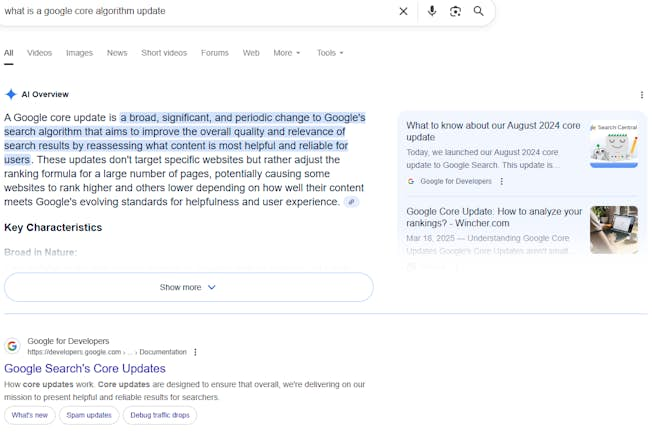
These AI Overviews now appear in over 200 countries and support more than 40 languages. When you search for complex questions today, you’ll often see these AI-generated summaries taking up the entire first screen, sometimes requiring multiple scrolls to reach traditional search results.
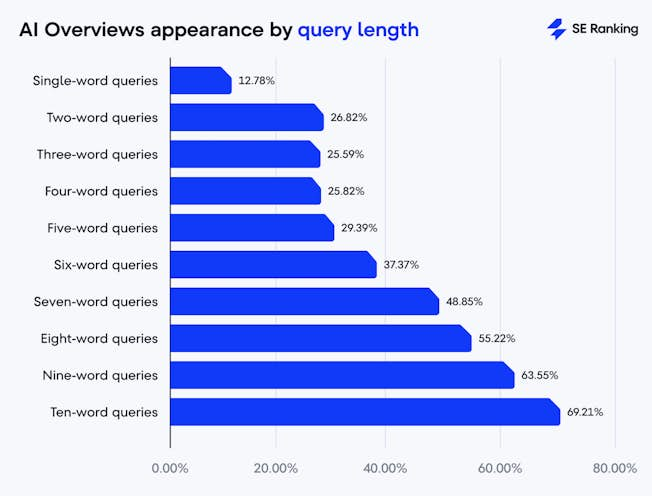
The adoption has been dramatic. During March 2025 alone, BrightEdge found AI Overviews appearing for 528% more entertainment queries, 387% more restaurant searches, and 381% more travel questions than before.
AI Mode: A completely different search experience
In May 2025, Google launched AI Mode, accessible through a new tab in the search bar. This isn’t just enhanced search results. When you click into AI Mode, you enter a ChatGPT-like interface where you can have actual conversations with Google’s Gemini AI about your search topic.
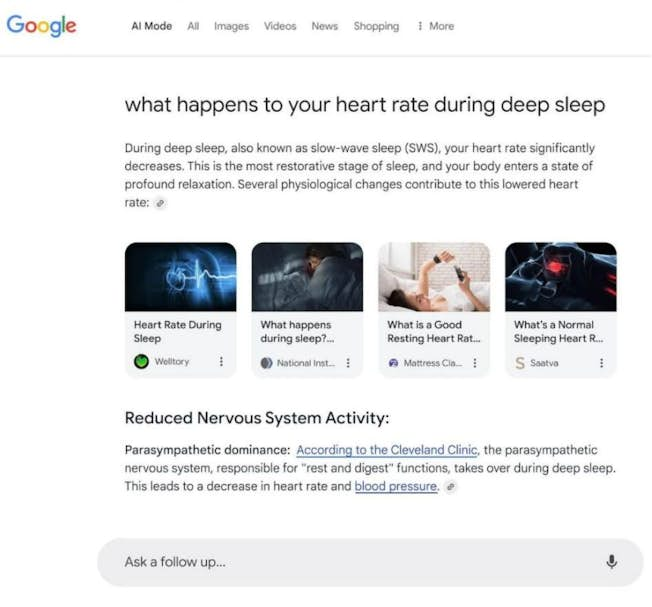
For example, instead of searching multiple times for “Paris hotels,” “Paris restaurants,” and “Paris attractions,” you could enter AI Mode and say “I’m planning a 5-day Paris trip with my kids, help me plan where to stay and what to do.” The AI responds conversationally, you can ask follow-ups like “what about rainy day activities?” and it maintains context throughout the conversation. It even includes a “Deep Search” button that researches hundreds of sources to create comprehensive reports on complex topics.
Zero-click searches: When nobody clicks through
Here’s what zero-click actually means: users get their answer directly on Google and never visit any website. SimilarWeb found that 69% of news-related searches now end without a click, up from 56% previously.
Why does this matter? If you run a recipe website and Google’s AI Overview shows your chocolate chip cookie recipe directly in search results, complete with ingredients and instructions, why would anyone click through to your site? Publishers lost 600 million monthly visits this way, going from 2.3 billion to 1.7 billion visits.
How ads fit into AI Overviews
Since June 2025, Google places advertisements directly within AI Overviews. These aren’t the traditional text ads you’re used to seeing. They’re integrated into the AI response itself. So an AI-generated answer about fixing a faulty oven might include a sponsored section for tool retailers, blended into the helpful content.
What this looks like by industry
Travel sites: When someone searches “best hotels in Rome,” Google’s AI Overview now provides a comprehensive guide with neighborhood recommendations, price ranges, and booking tips synthesized from dozens of travel sites. The actual travel sites that provided this information see 381% more of their content appearing in AI summaries, but far fewer actual visits. ChatGPT Agent goes one step further: it can go ahead and book the trip for you!
Restaurant searches: A search for “Italian restaurants near me” generates an AI Overview combining Google Maps data, reviews from multiple platforms, and even menu highlights. Review sites that used to get this traffic directly now watch Google summarize their content instead.
Health information: Medical queries trigger extensive AI Overviews with clear disclaimers about seeking professional help. Google applies stricter quality controls here, only pulling from authoritative medical sources.
Making your content work with AI
Since AI Overviews pull from existing web content, your SEO fundamentals still matter. But you need to structure content a bit differently:
- Write clear, definitive answers early in your content (AI systems often pull from opening paragraphs)
- Use descriptive headers that work as standalone statements
- Include unique data, quotes, or insights that AI systems want to cite
- Build comprehensive topic coverage so you become the authority AI references
Google still needs quality websites to generate these AI answers. Your goal is becoming the source that AI systems trust and cite, while also capturing traffic from queries too complex or transactional for AI to fully satisfy.
How should marketers respond to these updates?
Google’s algorithm updates continue to matter, but they’re now just one part of a much more complex ecosystem. Sites must optimize for traditional rankings, AI Overviews, and competing AI platforms simultaneously.
As a starting point, any marketers who want to understand what Google means by “quality content” should read the Search Quality Raters Guidelines.
It must be noted that this is not a direct insight into how Google’s algorithm works, and the guidelines do not shape the results we see. That said, they do tell us what Google wants its algorithms to deliver. As such, they are an essential reference point for marketers looking to prepare their content for the future of search.
By monitoring and adjusting your content strategy based on these updates, you can ensure your site aligns with Google’s evolving standards. Here are actionable steps for responding to these changes:
- Monitor Key Metrics: Track impressions, click-through rates, and rankings for insights into update impacts. As Google moves towards AI answers, you will want to monitor the impact on conversions and revenue, not just rankings.
- Benchmark Performance: Compare metrics before and after updates to identify affected areas. Monitor zero-click search impact on your key queries.
- Focus on Content Quality: Improve content depth, relevance, and authoritativeness to meet Google’s standards. If you are using AI to generate content, ensure that you have a human expert overseeing and editing the content before it goes live.
- Adapt SEO Practices: Regularly update your content and technical SEO based on evolving quality criteria and user experience requirements.
By implementing these steps, marketers can better align their strategies with Google’s expectations and maintain or improve their rankings post-update.


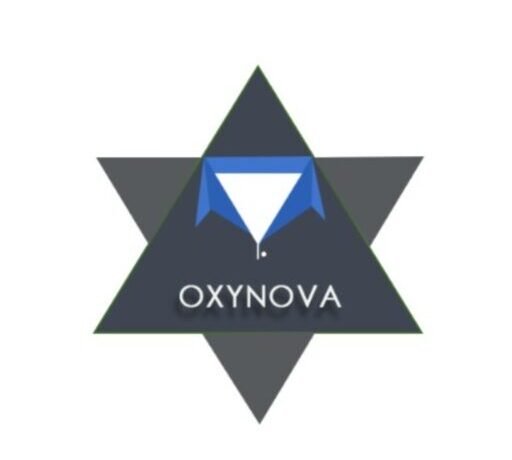
 Based in India, serving clients worldwide
Based in India, serving clients worldwide helloxynova@gmail.com
helloxynova@gmail.com LinkedIn | Instagram | Facebook
LinkedIn | Instagram | Facebook